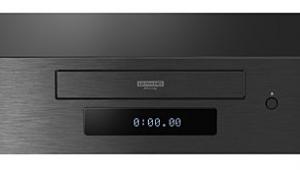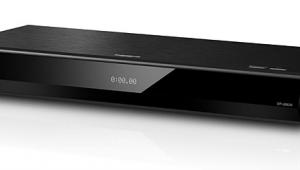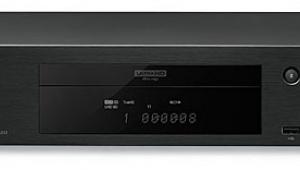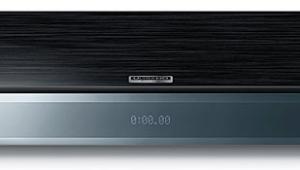Panasonic DMP-BD30 Profile 1.1 Blu-ray Player

The DMP-BD30, however, not only carries a significantly lower price tag ($499), but is a completely new design as well. In one important way it takes us closer to the ideal feature set that should have been designed into Blu-ray players in the first place. In another respect, however, it takes a step backward.
The Java Jive
BD-Java is the platform that the Blu-ray group chose for authoring the format's advanced interactivity, such as active menus, picture-in-picture for on-screen commentaries, Internet interoperability, etc. The DMP-BD30 is the first standalone player to market that complies with BD-ROM Profile 1.1 hardware requirements (we denotes "standalone player here because Sony's PlayStation3 meets the hardware requirements for both BD-ROM Profile 1.1 and 2.0, and its firmware update for Profile 1.1 compliance is imminent).
There are three current BD-ROM Profiles as they are formally called. Profile 1.0 is found in every other BD player released to date. With 64K of local storage (persistent memory), these players are woefully unprepared for new BD-J features. Profile 1.1 requires a minimum of 256MB of local storage and secondary audio and decoders for streaming Picture-In-Picture features and the like.
Note also that while Profile 1.1 is called the "Final Standard [BD-ROM] Profile" in Panasonic's promotional materials, it's not the last word in BD hardware. That's Profile 2.0 (so-called BD-Live), which requires 1GB of local storage plus network capability (likely in the form of an Ethernet or LAN port). No player currently offers BD-ROM Profile 2, but again, the PS3 meets the hardware requirements and is likely to be upgradeable to meet this spec.
The "local storage" does not need to be internal. A removable vehicle such as a flash drive or memory card can provide it. The Panasonic does have an SD card port, which may be used for the onboard memory required for some future disc features (see more on the SD card feature below). But it lacks an Ethernet port for Internet interactivity (not to mention direct downloading of firmware upgrades), so will never be upgradeable to Profile 2.0. But BD-ROM 1.1 is long overdue, and welcome with discs already announced with advanced interactivity for these new players to take advantage of.
You're probably curious, as I was, how this Profile 1.1 player handles BD-J encoded BDs. Does it load faster? Does it do magic tricks with the features on the discs?
Unfortunately, no. I tried loading three newer discs: The Fantastic Four: Rise of the Silver Surfer, Close Encounters of the Third Kind, and Cars. In all cases I skipped over the front-loaded trailers the instant they came on-screen. Compared to the Samsung BD-P1200, the DMP-BD30 turned in virtually identical times on Close Encounters of the Third Kind, and Cars. On FF it was roughly 30 seconds faster, but at 1 minute, 43 seconds, it's still no speed demon.
The DMP-BD30 has been more resistant to freeze-ups and glitches than the other Blu-ray players I've used. In fact, it hasn't had a single serious glitch. If my luck runs true to form, however, I'll experience one the day this review is posted—but it hasn't happened yet!
As a side note, there's a feature in the player that Panasonic calls "Virtual package." I'm unfamiliar with this term, but as Panasonic explains it, "For a disc compatible with the virtual package, data is copied to other media from the disc to use the different functions while playing the data. For this unit, data is (sic) copied to an SD card." Recall that the 256MB of local storage that a player must have to meet the standards of Profile 1.1 does not have to be inside the unit. Could it be that the local storage in the Panasonic is in the SD card (which must be provided by the user)? Panasonic does not say.
The Old Bitstream
Up until recently, the only way to hear the new, lossless Dolby TrueHD audio format from a BD (or HD DVD) was for the player to decode it to multichannel PCM and pass that along to the receiver or pre-pro either as HDMI digital audio or via the player's multichannel analog outputs. Most receivers produced over the past couple of years will accept and play multichannel PCM over HDMI, but not all.
The Panasonic is the first BD player we've reviewed that can retrieve full resolution TrueHD and DTS-HD Master Audio from a disc and pass them to a receiver in native bitstream form.
But Panasonic giveth and Panasonic taketh away. The DMP-BD30 lacks any internal capability to decode TrueHD, much less DTS-HD MA. This means that the only way you'll hear true lossless from this player is with a new AV receiver or pre-pro that can decode it from a native bitstream. This means only certain receivers released to market since mid 2007 need apply.
If you have an older receiver that cannot decode either new format, the only audio you will hear from the DMP-BD30, regardless of the pedigree of the selected soundtrack, will be straight Dolby Digital or DTS. It may arrive at the receiver in either PCM or bitstream digital form, depending on how the player is set up, or from the multichannel analog outputs, but in all such cases the limitation will be the same. On the upside, this audio will usually be at a higher data rate than is possible with the Dolby Digital or DTS available on DVD, and thus might well sound better. But it will not be lossless audio.
There is one other issue in a player that's unable to decode Dolby TrueHD. When you play a TrueHD disc with special features such as a video commentary track, the audio on that supplementary track must be combined with the movie's soundtrack before the audio is passed along to the receiver or pre-pro. That combining must be done using PCM, therefore the player must be able to decode the TrueHD on the main audio track into PCM. Since the Panasonic cannot do this, it may instead play a straight Dolby Digital or DTS soundtrack in the background when you choose the commentary track.
The player's HDMI output is 1.3, though Panasonic does not mention this in its specs. It does mention Deep Color, which requires HDMI 1.3 (Deep Color is a bit-hogging application that is, at present, vaporware).
- Log in or register to post comments






























































